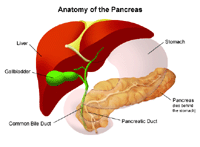The Pancreas: Anatomy and Functions
Anatomy of the pancreas
The pancreas is an elongated, tapered organ located across the back of the abdomen, behind the stomach. The right side of the organ is called the head. It is the widest part of the organ. It lies in the curve of the duodenum, the first part of the small intestine. The tapered left side extends slightly upward. It is called the body of the pancreas. It ends near the spleen, called the tail.
The pancreas is made up of 2 types of glands:
Exocrine. The exocrine gland secretes digestive enzymes. These enzymes are secreted into a network of ducts that join the main pancreatic duct. It runs the length of the pancreas.
Endocrine. The endocrine gland consists of the islets of Langerhans. It secretes hormones into the blood.
Functions of the pancreas
The pancreas has digestive and hormonal functions:
The enzymes secreted by the exocrine gland in the pancreas help break down carbohydrates, fats, proteins, and acids in the duodenum. These enzymes go down the pancreatic duct into the bile duct in an inactive form. When they go into the duodenum, they are activated. The exocrine tissue also secretes a bicarbonate. It neutralizes stomach acid in the duodenum.
The main hormones secreted by the endocrine gland in the pancreas are insulin and glucagon. They control the level of glucose in the blood, and somatostatin, which prevents the release of the other hormones.

Connect with us:
Download our App: